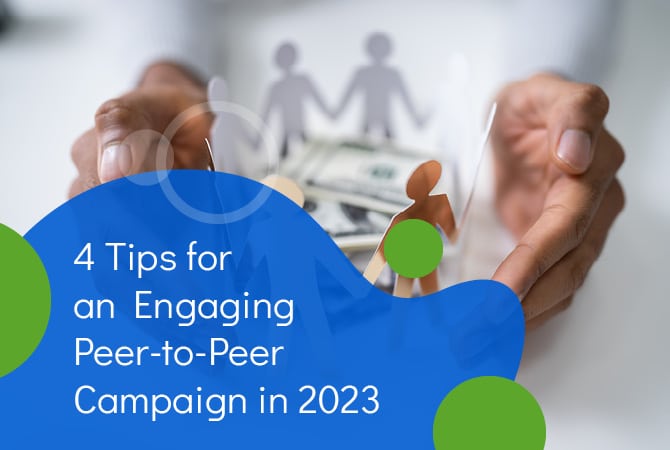
Guest Post by Brad Dowhaniuk, Co-Founder at 99Pledges
Peer-to-peer fundraising is a unique type of fundraising where individuals gather donations on behalf of your nonprofit organization. In today’s technological age, peer-to-peer fundraising usually occurs on social media platforms—participants share personalized donation pages with their family members and friends to gather donations for your organization.
However, peer-to-peer fundraising is not without its challenges. A common challenge that these campaigns face is a low participation rate. Let’s explore these tips for planning a peer-to-peer campaign that engages volunteer fundraisers and donors alike:
- Choose an enticing campaign idea.
- Set an achievable goal.
- Make it easy for supporters to get involved.
- Stay in touch with participants throughout the campaign.
In addition to nonprofit fundraising, peer-to-peer fundraising can also work well for school fundraising events. These tips will apply whether your audience is nonprofit supporters or your school’s community of students, parents, and staff. Let’s take a closer look at each strategy.
1. Choose an enticing campaign idea.
A common reason why some peer-to-peer campaigns are less successful is that the campaign idea isn’t interesting to the target audience. Make sure you pick a campaign that appeals to your target audience to entice them into participating. Here are some campaign ideas you can use to garner more support:
- Fun run/5K. 99Pledges’ guide to organizing a fun run recommends choosing exciting elements to spark interest in your running event. For example, you could host a color run or bubble run. You can implement peer-to-peer fundraising in your fun run or 5K by asking participants to raise funds for your organization as their entrance fee.
- Walk-a-thon or dance-a-thon. In these fundraisers, participants ask their family and peers to pledge a certain amount of money per unit of distance walked or per amount of time danced. For example, someone might pledge to donate $2 for every mile a participant walks.
- Social media challenge. A well-known example of a social media challenge is the ALS Ice Bucket challenge. During this challenge, participants tagged their friends and challenged them to either donate money or have a bucket of ice water dumped on them. Your organization can plan a similar challenge to engage audience members online. For instance, you might ask supporters to film themselves completing a dance sequence, eating a spicy pepper, or singing a few lines of their favorite song.
- Game night. Classic board games like Clue and Pictionary remain popular to this day, making a board game night a fun peer-to-peer fundraising idea. You might even use your school or event space to plan a scavenger hunt or escape room activity. To raise funds through these events, you could offer “advantages” to participants who have received more money donated to their personal campaign pages. You can also have people bid on “disadvantages” they can give to specific participants.
- Bake-off competition. Ask supporters to whip up their famous muffin or chocolate chip cookie recipe and join the running for the best baker at your fundraising event. Aside from having the usual panel of judges, you can also have attendants vote for a baker by donating to their campaign page.
Almost any fundraising idea or campaign can be made into a peer-to-peer campaign with some creativity. By choosing an engaging campaign idea for your peer-to-peer fundraiser, your campaign will be able to reach participants and donors that might otherwise have not even heard of you.
2. Set an achievable goal.
Having a clear and achievable goal will give your supporters a sense of accomplishment as they raise funds for your nonprofit organization. Here are some tips for setting those goals:
- Give supporters something to work toward. A goal shouldn’t be a huge stretch or incredibly difficult to attain, but your supporters should have to expend some effort to help you reach that goal. When participants put in more effort, they’ll be more invested in your success and will feel a greater sense of pride when your goal is reached.
- Connect your goal to specific impacts. Simply having a dollar amount as a goal may seem arbitrary to supporters. If you connect your goal to a concrete benefit, your donors will have a clearer picture of what their money is going towards. For example, you might say “If we can raise $10,000, our school will be able to purchase new laptops and smart boards for the media center.”
- Set different goal levels. Having multiple goals is another way to inspire participants. You may create a goal thermometer graphic and label it with different dollar amounts. Every time a goal is passed, the thermometer fills up. This gives donors an easy way of checking the campaign’s progress and may inspire them to give more so that the thermometer fills up even more.
- Set metrics to determine success. While the amount of money you bring in may be the most important metric for your nonprofit, it may not be the most important metric for your supporters. Tracking other metrics can also help you understand your supporters better and improve your campaigns in the future. You might track data such as total participants, total gift amount, largest gift amount, or average gift amount. If you’re hosting a walk-a-thon or fun run, you might track the number of miles walked or run.
Having clear goals for your participants and donors will give them an understanding of how well your campaign is doing. As supporters, they will want your campaign to succeed, and as long as your goal is achievable, they will put in more effort to accomplish that goal.
3. Make it easy for supporters to get involved.
Your fundraising campaign relies on supporters to succeed. It is imperative that it is easy for supporters to get involved. A frustrating experience can easily dissuade participants from lending you their aid again. Here are a few ways you can make things easier for your supporters:
- Leverage a user-friendly online fundraising platform. Search for a platform that is uncomplicated and easy to use. You can also look for a platform that creates fundraising pages automatically, so supporters don’t have to put in that effort.
- Create a peer-to-peer fundraising guide for participants. Some of your participants might never have tried peer-to-peer fundraising before, and a guide will give them a better understanding of the process. Include tips like the best times of day to post on social media, what to write in posts to encourage donations, and donation page design suggestions.
- Offer incentives for supporters to get involved. It may be difficult to convince supporters to put in the effort to help raise money for your nonprofit. Offering incentives, no matter how small, can persuade participants to help out and make a difference. Incentives could include free merchandise, gift cards, or flowers.
For a successful fundraising campaign, you want to remove as many barriers that prevent supporters from participating as possible. If participants have a smooth experience, they’ll think more positively about your nonprofit and may even participate in future events.
4. Stay in touch with participants throughout the campaign.
A peer-to-peer fundraising campaign can take place over the course of a month or two. During this extended period, it can be easy for participants to forget about the campaign or let it fall by the wayside. Here are some easy ways for you to stay in touch with your supporters:
- Encourage fundraisers to keep sharing their donation pages to reach their goals. Send words of encouragement via email or social media posts from your organization’s main account. You can even incorporate gamification elements such as leaderboards or a points system to reward and recognize top fundraisers.
- Personalize your appreciation efforts, such as your donor thank-you letters and emails. Thank your supporters for the work they are doing to help your organization. You can use your CRM to personalize these messages with supporters’ first and last names. Another way to recognize the work they’ve done is by mentioning the specific amount they’ve raised for your nonprofit or by letting them know if your campaign has reached a goal.
- Invite participants to a special event to wrap up the campaign and show your appreciation. An example of a thank-you event could be a dinner, gala, or concert. Consider hosting a webinar or livestream so that supporters can attend your event virtually.
Staying in touch with your supporters will encourage them to continue participating in your campaign. It’s important to remind campaign participants that their efforts have a direct positive impact on your cause, as well as show your appreciation for their hard work.
Peer-to-peer fundraising campaigns can expand your network to new supporters that you might otherwise not be able to reach. Plus, according to Bloomerang’s peer-to-peer fundraising guide, they can give your existing supporters a new and unique way to show their support. They let your supporters get more involved with the fundraising process in a hands-on way and help you grow your social media presence.
By choosing an engaging campaign idea, setting an achievable but ambitious goal, and staying in touch with supporters throughout the fundraising process, you can make this year’s peer-to-peer fundraisers your most successful campaigns yet.

About the Author
Brad Dowhaniuk is the co-founder of 99Pledges, which provides schools and teams with an easy-to-use, web-based fundraising solution to manage and drive success in Fun Runs, jog-a-thons, baseball hit-a-thons, and much more.
